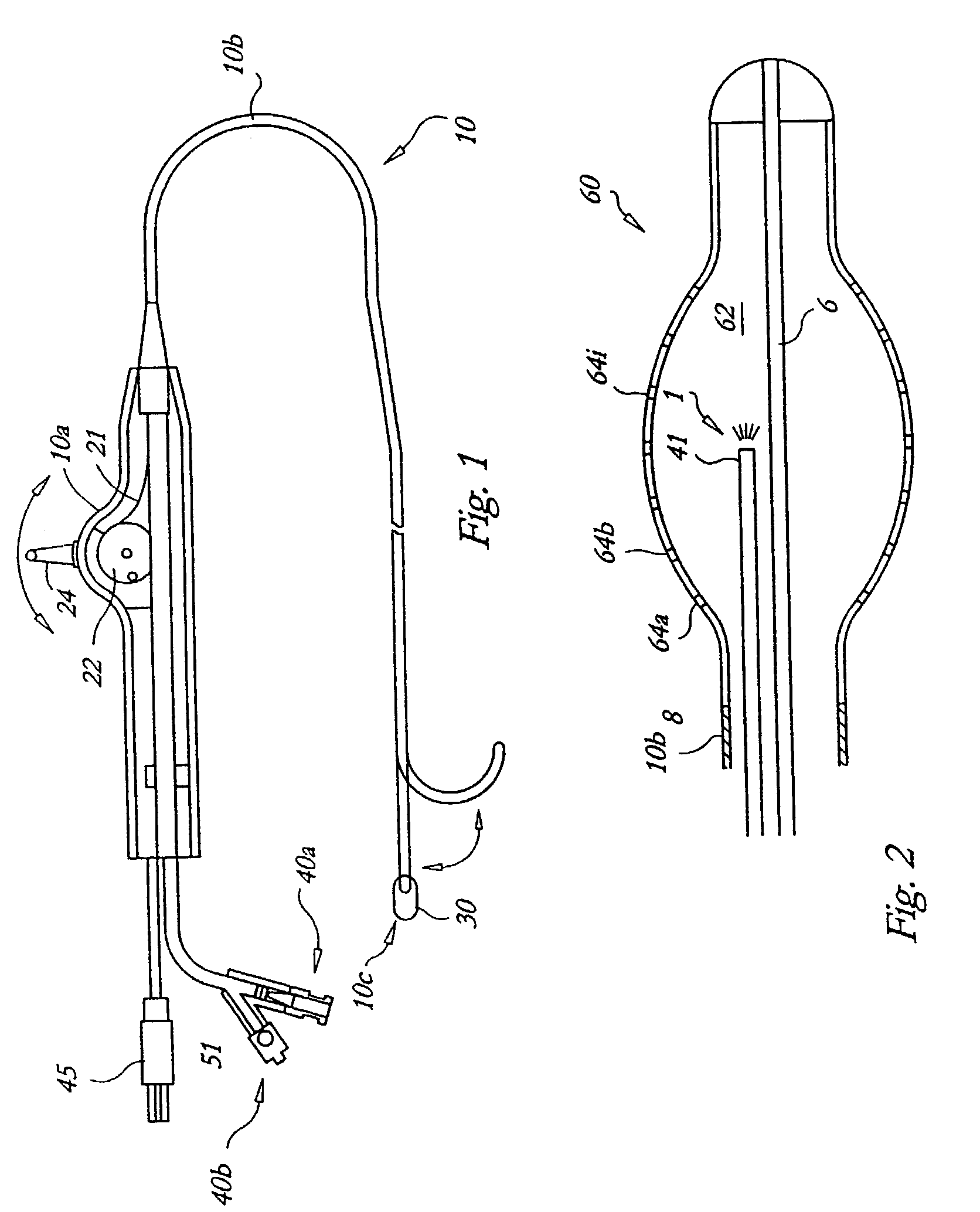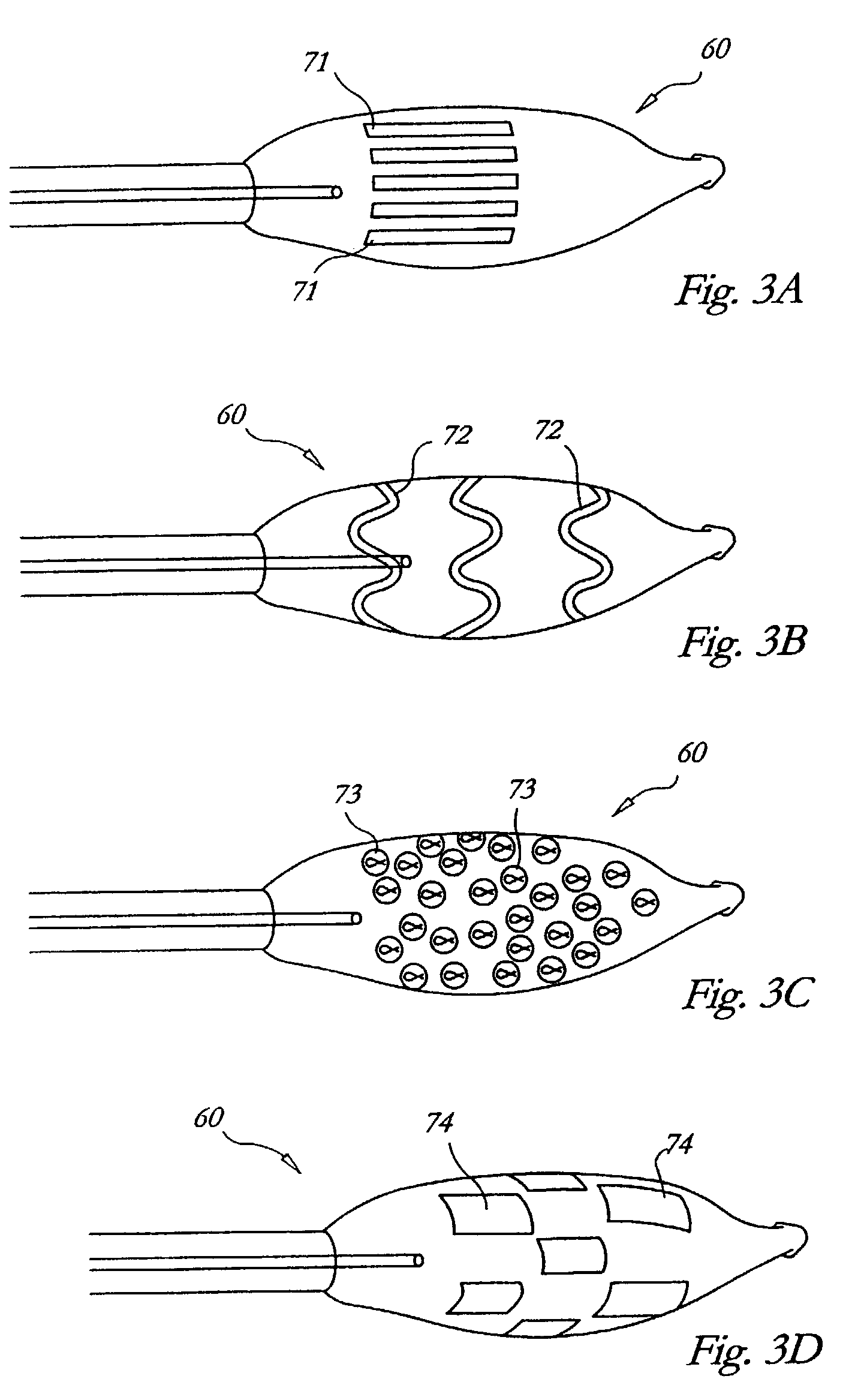Endovascular cryotreatment catheter
a cryotreatment catheter and endovascular technology, applied in the field of endovascular catheters, can solve the problems of high turbulent flow conditions, limited cooling rate, and constraints on the working devi
- Summary
- Abstract
- Description
- Claims
- Application Information
AI Technical Summary
Benefits of technology
Problems solved by technology
Method used
Image
Examples
embodiment 80
[0047]FIG. 4 illustrates another embodiment 80 of the present invention. This embodiment has a multi-balloon structure and a cooling segment 84 at the catheter tip. As illustrated, segment 84 corresponds to the expansion chamber or region of greatest cooling activity of the catheter and includes a cooling pattern assembly. This may be a spiral metal wrapping that provides stiffness, form and thermal conductivity to the segment. A first balloon 82 is positioned on one side of the cooling segment 84 to serve as an anchor and blood vessel occluder or flow blocker, and in this embodiment a second balloon 86 extends from the other end of the cooling segment. As shown, the first balloon is substantially ovaloid and symmetrical, while the second balloon 86 has a tapered, trumpet-or bell-shaped aspect that allows it to wedge at the end of a vessel, for example, in the ostium or junction of the vessel end to an organ. Thus, while the balloon 82 is inflatable within a vessel to serve as an an...
embodiment 400
[0065]The illustrated embodiment of FIG. 10A has a generally continuous balloon contour in which at least a portion of the end segments 312a, 312b inflates to the diameter of the surrounding blood vessel or tissue lumen and serves to displace blood, fluid or tissue away from the cryogenic treatment portion at the center of the catheter tip. As shown in FIG. 10B, this has the effect of creating a cooling region that forms a relatively symmetrical ice ball volume (indicated by dashed lines in the Figure) around the vessel and catheter tip, with greater depth of penetration centered directly over the cryogenic chamber and with cooling damage tapering off away from that region. The balloon need not be a single continuous or partitioned balloon but may be implemented with separate balloons that in turn may be inflated via separate filler or inflation tubes (not illustrated) so as to more effectively achieve or more independently initiate the blocking and heat isolation functions. FIG. 10...
embodiment 700
[0071]FIG. 12B illustrates another embodiment 700 of a cryogenic delivery catheter of the invention. This embodiment again has the basic structure of a cooling chamber 703 in a distal cooling tip 710 fed by a coolant supply lumen 701. However, in this embodiment an additional fluid delivery line 725 extends through the catheter body and is mounted to deliver fluid F externally of the tip 710 into the space between the cooling chamber exterior wall and the surrounding tissue. The delivery line 725 may have one or more outlets positioned to provide fluid F in defined locations. As illustrated in phantom by element 715, a perforated membrane or other external distribution structure may also be provided to disperse or spread the fluid F exiting the delivery line 725. In general, the delivery line 725 may deliver a therapeutic treatment liquid, or simply a heat conduction fluid to cryochamber surface. Applicant contemplates generally that during cryotreatment, the fluid F will freeze in ...
PUM
 Login to View More
Login to View More Abstract
Description
Claims
Application Information
 Login to View More
Login to View More - R&D
- Intellectual Property
- Life Sciences
- Materials
- Tech Scout
- Unparalleled Data Quality
- Higher Quality Content
- 60% Fewer Hallucinations
Browse by: Latest US Patents, China's latest patents, Technical Efficacy Thesaurus, Application Domain, Technology Topic, Popular Technical Reports.
© 2025 PatSnap. All rights reserved.Legal|Privacy policy|Modern Slavery Act Transparency Statement|Sitemap|About US| Contact US: help@patsnap.com



